
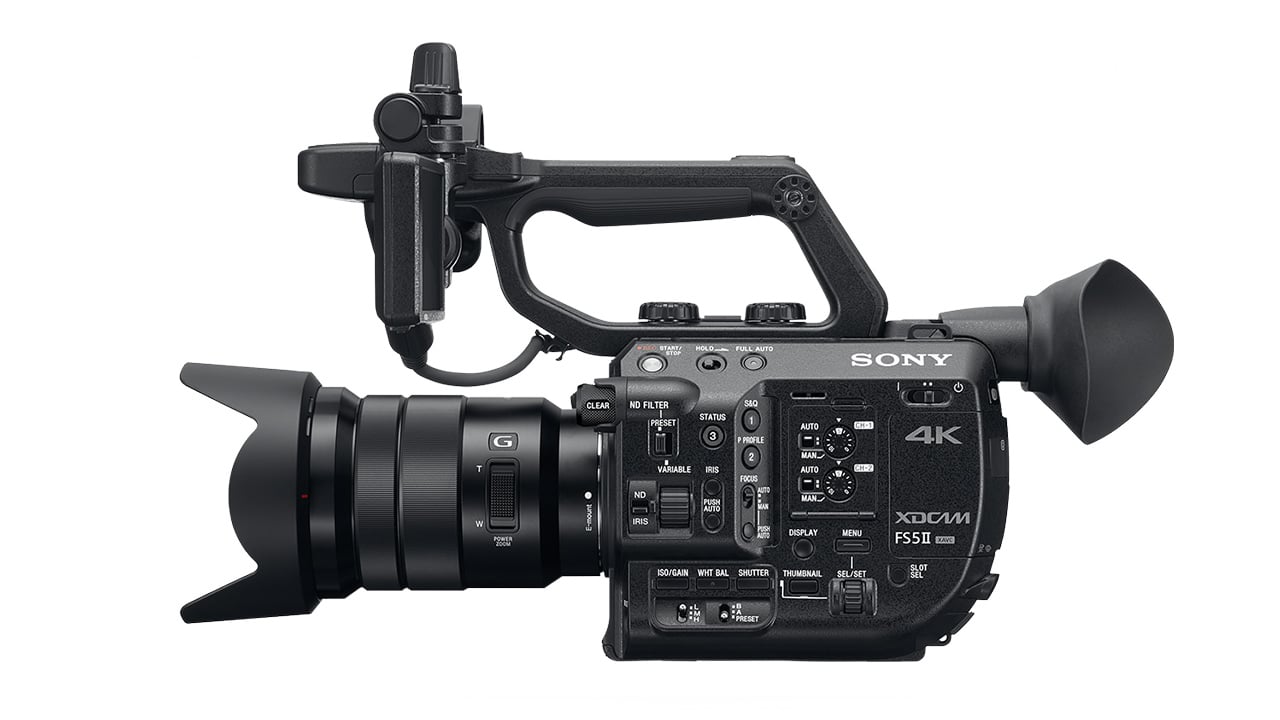
The new Sony PXW-FS5M2 has had a lot of hype recently for its Venice-stye colour science. What's it like in the real world, and is it worth the upgrade? Read on to find out.
The Sony FS5 is pretty widely known as a very popular camera. The smaller sibling to the FS7, it has become a workhorse camera to many production outfits due to its compact size, light weight, and its flexible recording options. But now Sony has released the FS5M2, an addition to the FS5 fleet rather than a replacement, since the original version will remain very much for sale as a current camera.
Despite the original FS5 having been available for while now, not everyone reading this review will be familiar with the camera directly as a user. So in addition to the new features I will be reviewing the M2 from the point of view of never having used one before.
Overview
The FS5M2 is a light-weight camera. Its overall appearance is literally that of a shrunken FS7. It uses the Sony E-mount lens system, which is known for its ability to be easily adaptable to the many different popular lens types out there such as Canon's ubiquitous EF Mount. Our review sample was supplied with a Sony 18-105mm f/4 zoom lens.
As per most Sony cameras the control and button layout is nicely spaced and clearly labelled. Some of the most used menu functions are mapped onto the buttons such as the S&Q (slow and quick) function, and Picture Profile, which saves having to delve through the menus all the time.
Of note is the ND control. ND on the FS5 can be selected either by using a traditional rotary knob, or by putting the camera into the unique electronically variable ND mode. This allows the amount of ND to be dialled in with almost infinite precision. Again, a very handy feature to have. This variable ND is controlled with a rotary dial that can be switched between controlling ND or the iris.
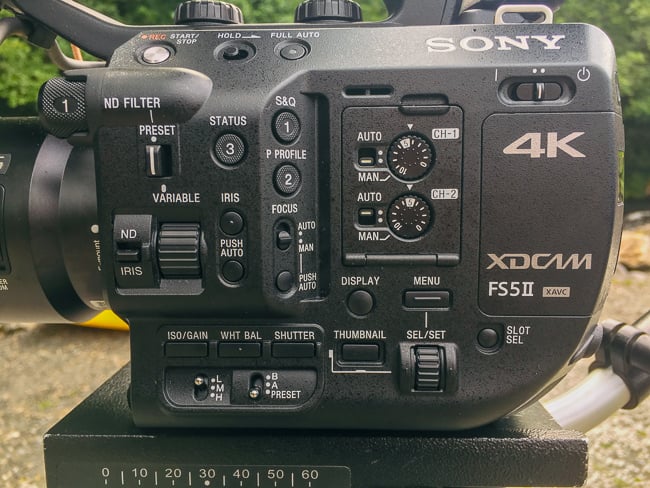
Clearly labelled and well spaced buttons and controls on the FS5M2 body.
Gain and white balance presets are taken care of with metal switches, placed in the now familiar lower left hand side of the camera body, while audio controls are placed prominently near the rear left of the camera.
Usefully there are three record buttons. One on the top left of the body, one placed on the very top front of the carrying handle, and another on the hand grip. So no matter which side of the camera you are standing or holding it, you can always easily access a record start button.
As is usual for Sony cameras there are a good number of assignable buttons. Some of these are taken up by default by functions such as the Picture Profile, but they can all be re-assigned to the function that you want to access most. In all there are five buttons that can be customised in this way.
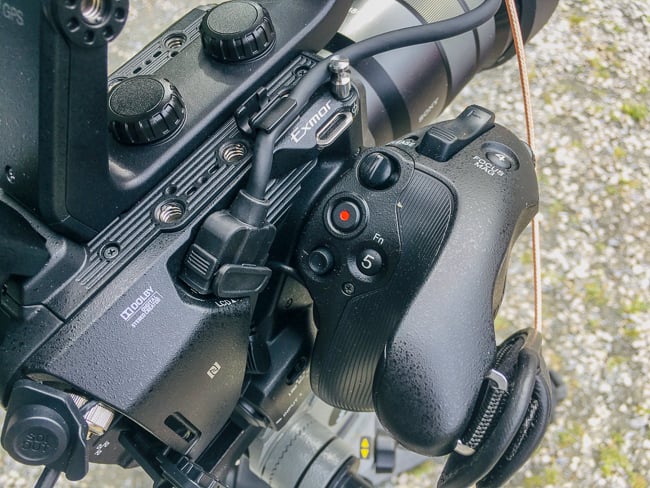
The removable and rotatable hand grip allows easy access to all of the important controls in handheld configuration
As is becoming more normal to a degree, the FS5 can be deconstructed, with handles, LCD monitor, and hand grip all removable so that the camera can be configured for easy use on gimbals, drones, and for better balance on Steadicam style systems. The top of the body, particularly when the handle is removed, contains numerous screw fixing points to mount custom accessories to. These same fixing points are also intended for the camera's supplied LCD display. Not only can this be mounted in three separate positions on the handle, but if this is removed the LCD can be mounted on any one of the six points along the top of the camera body.
For output it has one SDI, and one full size HDMI port. Audio input is via two XLR in sockets. I can't say that these are mounted in the most intuitive of places (I had to search around for the second input), but with such a small camera body it isn't always easy to find an easy placement for these. Nevertheless, this is all solidly put together as you would expect.
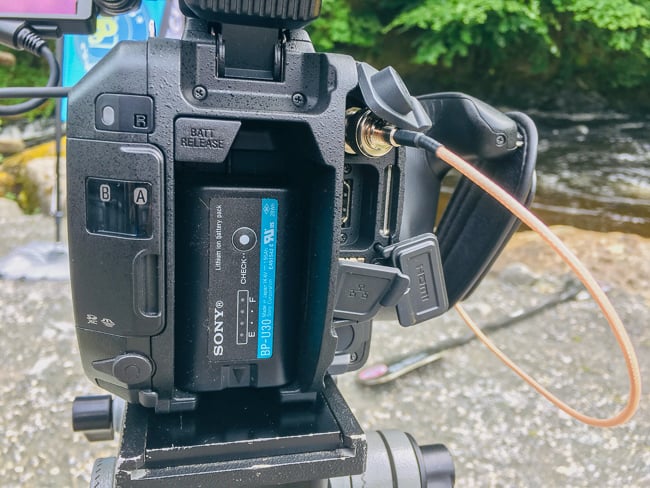
The rear of the FS5M2 showing the HDMI and SDI ports, as well as SD card slot position.
Power on.
Starting the FS5M2 is a fast affair. I think we've reached the point where for the most part cameras do now fire up very quickly. The camera we were supplied with had one BP-U30 battery, the smallest one that can be used with it. Even so, the FS5M2 has a low power draw of around 12.5w with the LCD and EVF turned on, meaning that one BP-U30 can last roughly 2hrs continuously. Your mileage may vary of course depending on the conditions, but in my tests this would appear to be just about right.
There is one caveat with power-on times to be aware of when using an external device. During my tests I also used an Atomos Shogun Inferno with slow motion. The Inferno takes a few seconds to recognise the output, especially when the FS5M2 is switched into S&Q mode. If you are trying to shoot quickly and want to capture the moment one suggestion I would have for Sony in a future firmware update is to allow, if you want it to, the FS5M2 to remember that it was in S&Q mode when it was last switched off. Otherwise if you are filming a lot of slow motion it can take quite some time before you can hit the record button. This is just a minor niggle and it is one that could be sorted out in firmware.
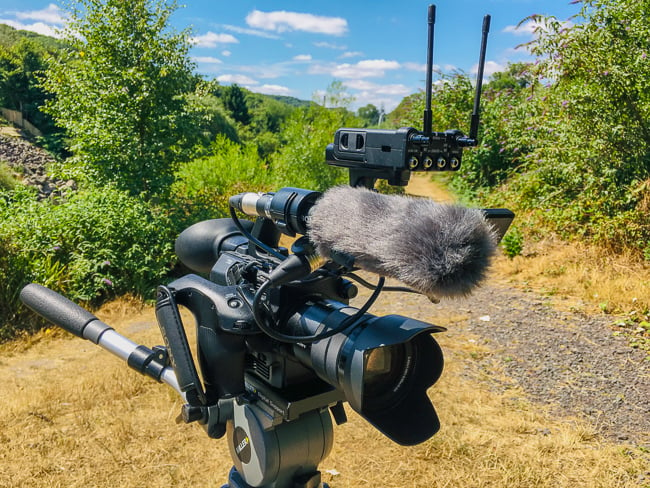
The FS5M2 with additional external mic and Sony URX-P03D wireless audio receiver, which interfaces directly with the top front hotshoe.
Picture performance and FS5M2 differences
The picture quality is one area where the original FS5 and the new camera start to diverge. I must stress strongly that this is nothing to do with noise performance or dynamic range. Placing both cameras into RAW output, if you have the option installed on the Mk1, will give you very similar results.
However the big change is with the M2's default colourspace. Sony have effectively taken what they have learnt from developing the colour science for the Venice and put their knowhow into a new default colour and gamma setting for the FS5M2.
From discussions I've been having it would appear that this new colour science is not simply a LUT, but actually operates on a much deeper level. In other words even if Sony wanted to, they wouldn't be able to retro install it onto the original FS5.
We did a live demonstration of the differences between the two cameras default settings on RedShark Live recently. At first it is difficult to discern the differences. But once you see them, boy is it hard to 'unsee' them!
Not only is the colour seemingly far more accurate on the new camera, but the colour shades themselves are much more subtly handled, particularly in the highlights. Take a tree leaf for example. The original FS5 looked great, but in comparison to the FS5M2's new colour setting the first camera positively looks flourescent. The new camera looks far more realistic in comparison. The default gamma gives a very pleasing roll off to the highlights as well as keeping much more natural tones and texture. Both these factors help particularly when it comes to skin tones and skin highlights. In fact skin tones are an area for which Sony placed a lot of emphasis when they developed this mode, and it shows.
I've included some comparison shots between the two cameras standard modes below. I've purposefully done this in some very challenging mid-afternoon light using only a basic reflector to add some fill to the shadows. These weren't meant to be high art, just a quick way to show you how the different cameras compare.

This is the standard mode on the FS5M2

This is standard mode on the original FS5. Note the sky saturation and the detail of Emily's clothing in the highlights

Here is the FS5M2 standard colour and gamma with the exposure increased

The original FS5 gamma. Note how the texture on the picnic table compares with the previous image, as well as the sky
Go here to download full resolution screen grabs that compare the different standard settings on the two cameras.
Effectively what you have with the new colour science is a very pleasing look that captures a very nice amount of dynamic range that can be used straight out of the camera with minimal tweaking, save for user errors such as slight under or over exposure. For people who are tired of having to shoot in log modes all the time to ensure a pleasing look, a default mode such as this will come as an extremely welcome relief.
If log shooting is your thing, or you need to shoot for HDR in general, the camera still includes the option of S-log2 and S-Log3, as well as HLG capabilities. The new colour is very good indeed, but S-Log and raw shooting are also a very important capability for this camera as you will see.
Slow motion
Love it or hate it - I happen to love it - slow motion has become an important requirement for any new camera. With the FS5M2 it is possible to record 1960x1080 (not a typo: that is the correct resolution) slow motion in full HD at 422 10-bit colour precision at up to 120fps either continuously or in a 16 second buffered burst. Speeds of up to 240fps at the same resolution can be made in bursts of up to eight seconds. Higher speeds up to 960fps are possible but at the expense of resolution.
It is when it is connected up to an external recorder that the FS5M2 becomes a truly useful slow motion beast. Doing this by selecting the RAW output via SDI to a device such as the Shogun Inferno or an Odyssey 7Q opens up much more flexibility. For example you can then shoot up to 240fps continuously at 2K resolution, while 4K resolution can be shot using a 4 second buffer.
In order to do this usefully the camera needs to be set to output timecode as well as a record trigger signal. Then the external device has to be configured to recognise this. This way as soon as you press record on the M2 body the external recorder will kick into action. This is essential for recording the 4K slow motion since the camera will write the buffer to the recording device after the record button has been pressed.
Presently, despite the need to have an external monitor/recorder this makes the FS5M2 the most affordable way to record full 4K RAW slow motion over and above 60fps. Despite the 4 second buffer limitation, this is enough to capture fast moving subjects, especially when it is placed into "End Trigger" mode, which buffer records the four seconds of footage prior to the record button being pressed. But perhaps more usefully the 240fps continuous recording mode offers a slow motion ability not heard of in any other camera of this price except for the original FS5 with the optional additional functionality enabled.
There is a caveat to all of this if you are using the new standard colour mode. If you want 4K slow-mo you will have to record it using an external recorder, and then grade and match later. I haven't yet tried doing this so I do not know how difficult this would be to do. But my recommendation would be that if you are shooting lots of slow motion to record everything to the external recorder, or normal speed footage internally to the camera in S-log2 if you want to save space. Otherwise you will need to record your slow motion at HD resolutions internally to the camera. Your decision will of course be based upon the final output requirements and budgets etc.
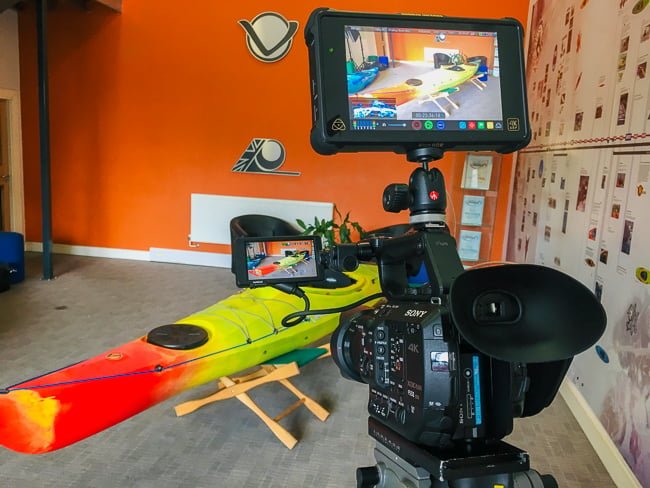
Shooting with an Atomos Shogun Inferno attached
In use
To use the FS5M2 is a pleasure. It is just about the right size. Not too large so as to be cumbersome and not so small as to be fiddly. The detachable rotatable hand grip provides access to important functions when handheld such as the iris, as well as the ability to cycle through other settings such as the shutter and gain without needing to touch the left hand side of the camera. With a bit of deft practice it should become second nature to move around these settings quickly. It's nowhere near as fast as direct input to the lens, but with many people using stills camera lenses it does add some convenience to handheld scenarios.
Final thoughts
The big question on existing FS5 owners lips will be whether the new camera renders their current one obsolete. The fast answer is no. The original FS5 remains a current member of the Sony line-up, and if you have the additional options for RAW and super slow motion installed the only thing you will really be missing is the new colour science. If on the other hand I didn't already own an FS5 I would certainly think seriously about buying the new version simply because the new colour science is so pleasing. I have really enjoyed my time with the FS5M2. It ticks all the boxes for such a camera, and then ramps it up with its new colour science and fantastic slow motion abilities. Highly recommended.
The FS5M2 sells for around £4300+vat ($4800 USD).
I have included some test footage below. Again this isn't high art, but particuarly in the factory shows how the camera will look in the type of everyday circumstances that shooters often find themselves in.
Tags: Production


Comments